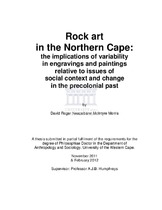| dc.description.abstract | This thesis follows and builds upon a previous study at the rock engraving site of Driekopseiland (Morris 2002). The earlier findings are here contrasted with another site in the area, namely Wildebeest Kuil, as a means to highlight the variability which is a feature of the rock art of the Northern Cape as a whole. The main thrust of the thesis, which refers to a number of other rock art sites in the region, is to model the implications of this variability relative to social context and history in the precolonial past. Significant empirical obstacles, particularly the difficulties associated with dating rock art, render some aspects of the enterprise intractable for the time being. But opportunities are pursued to advance and evaluate ideas as to the social mechanisms and processes which might be implicated in the making and re-making of images on rock and in the generation of the diversity that is manifest in the rock art as it is found today. Whereas other approaches have tended to explain difference relative to social entities such as ‘cultures’ or ‘ethnic groups’, this thesis offers, as a point of departure, a critique of received concepts, reconsidering some of the fundamental metaphors and assessing the elaboration of analogies that have been used in the past. It proposes that better theoretical footholds might be those that explain variability relative to process and movement. It invokes Tim Ingold’s concept of a meshwork of dynamic relationships of people immersed in the world, of ‘entanglements’ that refer to multiple mechanisms that might explain how rock art has changed in place and time. The pertinence of these ideas is shown with reference to specific instances in the Northern Cape.As a parallel weave in this study, there is a concern over the social role of archaeology, with discussion on the burgeoning salience of rock art beyond the academy, in the heritage and tourism sectors and amongst descendants of the Khoean. The thesis gives consideration to the role of museums and research in terms of “heritage in practice,” and seeks to develop a discourse in which, following Alexander, “everything can be perceived as changing and changeable” – an underlying theme throughout the study. The thesis does not bring empirical closure to the topic but suggests a programme for future engagement, having opened up and shown the relevance of wider theoretical insights for addressing the variability in the rock art of the Northern Cape | en_US |

